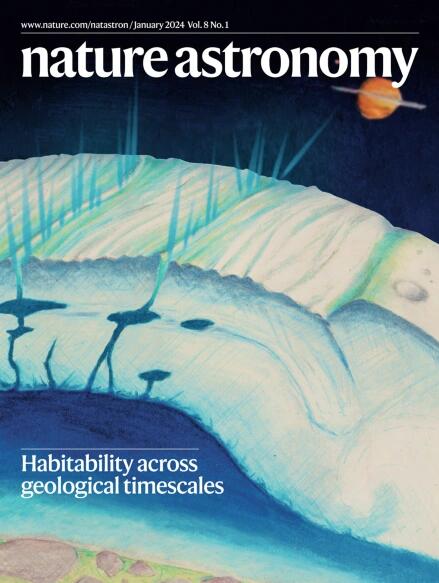Abundant ammonia and nitrogen-rich soluble organic matter in samples from asteroid (101955) Bennu
IF 12.9
1区 物理与天体物理
Q1 ASTRONOMY & ASTROPHYSICS
引用次数: 0
Abstract
Organic matter in meteorites reveals clues about early Solar System chemistry and the origin of molecules important to life, but terrestrial exposure complicates interpretation. Samples returned from the B-type asteroid Bennu by the Origins, Spectral Interpretation, Resource Identification, and Security–Regolith Explorer mission enabled us to study pristine carbonaceous astromaterial without uncontrolled exposure to Earth’s biosphere. Here we show that Bennu samples are volatile rich, with more carbon, nitrogen and ammonia than samples from asteroid Ryugu and most meteorites. Nitrogen-15 isotopic enrichments indicate that ammonia and other N-containing soluble molecules formed in a cold molecular cloud or the outer protoplanetary disk. We detected amino acids (including 14 of the 20 used in terrestrial biology), amines, formaldehyde, carboxylic acids, polycyclic aromatic hydrocarbons and N-heterocycles (including all five nucleobases found in DNA and RNA), along with ~10,000 N-bearing chemical species. All chiral non-protein amino acids were racemic or nearly so, implying that terrestrial life’s left-handed chirality may not be due to bias in prebiotic molecules delivered by impacts. The relative abundances of amino acids and other soluble organics suggest formation and alteration by low-temperature reactions, possibly in NH3-rich fluids. Bennu’s parent asteroid developed in or accreted ices from a reservoir in the outer Solar System where ammonia ice was stable. Rocks and dust from the asteroid Bennu contain some of the molecular building blocks of life on Earth, such as amino acids and nucleobases. They also carry ammonia that formed billions of years ago in cold, distant regions of our Solar System.


小行星Bennu(101955)样品中含有丰富的氨和富氮可溶性有机物
陨石中的有机物揭示了早期太阳系化学和对生命重要的分子起源的线索,但陆地暴露使解释变得复杂。由起源、光谱解释、资源鉴定和安全风化层探测任务从b型小行星Bennu带回的样本使我们能够在不受控制地暴露于地球生物圈的情况下研究原始的碳质天体物质。在这里,我们展示了Bennu样本是挥发性丰富的,比小行星Ryugu和大多数陨石的样本含有更多的碳,氮和氨。氮-15同位素的富集表明氨和其他含氮的可溶性分子是在冷分子云或外原行星盘中形成的。我们检测到氨基酸(包括陆地生物学中使用的20种氨基酸中的14种)、胺、甲醛、羧酸、多环芳烃和n -杂环(包括DNA和RNA中发现的所有五种核碱基),以及约10,000种含氮化学物质。所有的手性非蛋白质氨基酸都是外消旋的或接近外消旋的,这意味着陆地生命的左手手性可能不是由于撞击带来的益生元分子的偏倚。氨基酸和其他可溶性有机物的相对丰度表明,可能是在富含nh3的流体中通过低温反应形成和改变的。本努的母小行星是在太阳系外一个氨冰稳定的储存库中形成或吸收冰的。
本文章由计算机程序翻译,如有差异,请以英文原文为准。
求助全文
约1分钟内获得全文
求助全文
来源期刊

Nature Astronomy
Physics and Astronomy-Astronomy and Astrophysics
CiteScore
19.50
自引率
2.80%
发文量
252
期刊介绍:
Nature Astronomy, the oldest science, has played a significant role in the history of Nature. Throughout the years, pioneering discoveries such as the first quasar, exoplanet, and understanding of spiral nebulae have been reported in the journal. With the introduction of Nature Astronomy, the field now receives expanded coverage, welcoming research in astronomy, astrophysics, and planetary science. The primary objective is to encourage closer collaboration among researchers in these related areas.
Similar to other journals under the Nature brand, Nature Astronomy boasts a devoted team of professional editors, ensuring fairness and rigorous peer-review processes. The journal maintains high standards in copy-editing and production, ensuring timely publication and editorial independence.
In addition to original research, Nature Astronomy publishes a wide range of content, including Comments, Reviews, News and Views, Features, and Correspondence. This diverse collection covers various disciplines within astronomy and includes contributions from a diverse range of voices.
 求助内容:
求助内容: 应助结果提醒方式:
应助结果提醒方式:


